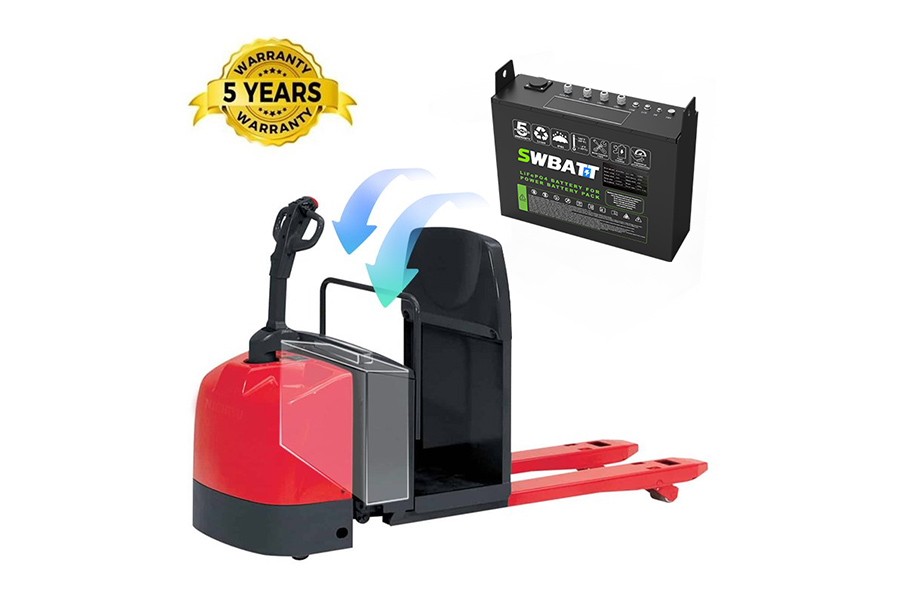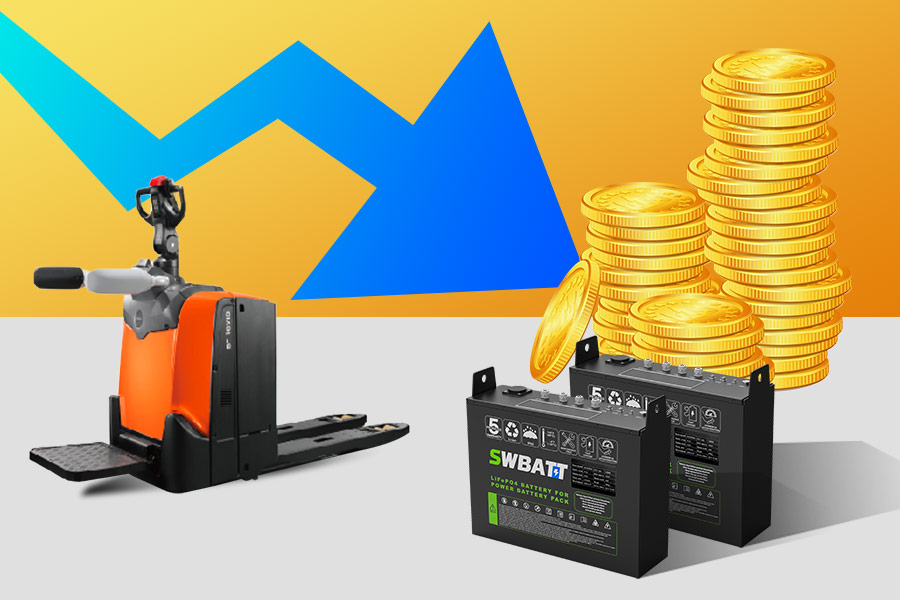Introduction
A failing battery in your Crown forklift can disrupt your operation. Knowing which Crown forklift battery replacement you need, how to install it safely, and how to troubleshoot common issues is essential for minimizing downtime and maximizing your investment.
We at SWBATT specialize in lithium-ion battery solutions. This guide provides specific, actionable information to help you find the correct battery, replace it correctly, and address common problems.
Identifying Your Crown Forklift Model and Battery Needs
The first step is identifying your exact Crown forklift model (found on the data plate). Common series include:
- Crown PE Series (Walkie Pallet Jacks): Often 24V.
- Crown WP Series (Walkie Pallet Jacks): Typically 24V.
- Crown PTH Series (Hand Pallet Jacks): You may use 12V or 24V.
- Crown RC Series (Stand-Up Counterbalanced): Often 36V or 48V.
- Crown FC Series (Sit-Down Counterbalanced): Can be 36V, 48V, or 80V.
- Crown SP Series (Stockpickers): Often 24V or 36V.
- Crown RR Series (Reach Trucks): Commonly 36V or 48V.
Consult your owner’s manual or a Crown dealer for exact specifications:
- Nominal Voltage: (e.g., 24V, 36V, 48V)
- Capacity (Amp-hours, Ah): Determines runtime.
- Connector Type: (e.g., SB175, SB350, Euro) – Crucial.
- Battery Dimensions
Lead-Acid vs. Lithium-Ion for Crown Forklifts: A Quick Comparison
| Feature | Lead-Acid | Lithium-Ion | Key Takeaway |
| Lifespan | Shorter (1500-2000 cycles) | Longer (3000-5000+ cycles) | Lithium lasts 2-3x longer. |
| Maintenance | High (Watering Required) | None | Lithium saves time and labor. |
| Charging | Slow & Conventional | Fast & Opportunity | Lithium increases uptime. |
| Weight | Heavier | Lighter | Lithium improves maneuverability. |
| Voltage Drop | Significant | Minimal | Lithium provides consistent power. |
| Initial Cost | Lower | Higher | Lithium often has lower total cost. |
Why Choose a Lithium-Ion Upgrade?
Upgrading offers:
- Increased Uptime: Fast & opportunity charging.
- Lower Costs: Reduced energy, no maintenance, longer life.
- Productivity: Consistent power, less downtime.
- Safety: No watering/gassing, built-in BMS.
- Environment: Longer life, recyclability.
Discover Advanced Lithium Battery Solutions
Explore SWBATT‘s innovative LifePO4 batteries for electric vehicles, energy storage, and more. Tailored solutions to meet your energy needs with efficiency and sustainability.
Crown Forklift Battery Selection Guide
This table helps narrow down options. Always verify with your manual or a Crown dealer.
| Crown Model Series (Example) | Typical Voltage | Typical Connector(s) | Usage Scenario | Lead-Acid Recommendation | Lithium-Ion Recommendation (from SWBATT) |
| PE 4500 | 24V | SB175, SB350 | Moderate to Heavy Duty | (Specific model if known) | 24V lithium forklift batteries |
| WP 3000 | 24V | SB175 | Light to Moderate Duty | (Specific model if known) | |
| RC 5500 | 36V/48V | SB350, Euro | Heavy Duty, Multi-Shift | (Specific model if known) | 36V lithium forklift batteries |
| FC 4500 | 36V/48V/80V | SB350, Euro | Heavy Duty | (Specific model if known) | |
| SP 3500 | 24V/36V | SB175, SB350 | Medium Duty | (Specific model if known) | |
| RR 5700 | 36V/48V | SB350, Euro | Heavy Duty | (Specific model if known) | SWBATT Forklift Batteries |

How to Use:
- Find Your Model: Locate your series in the left column.
- Check Specs: Note voltage and connectors. Confirm with your manual.
- Assess Usage: Consider intensity (shifts, loads).
- Review Recommendations: See lead-acid (if applicable) and lithium-ion options. Click links for details.
Step-by-Step Crown Forklift Battery Replacement Guide
Safety is paramount! Before starting, read your Crown forklift’s manual and all safety guidelines. Wear appropriate PPE (safety glasses, gloves, steel-toed shoes).
Tools You May Need:
- Insulated Wrench Set
- Battery Lifting Beam/Sling (rated for battery weight)
- Voltmeter (optional)
- Hydrometer (for lead acid, to check specific gravity)
- Distilled Water (for lead acid, if topping off before disposal)
Steps:
- Preparation:
- Park the forklift on a level surface in a designated area.
- Turn off the forklift, remove the key, and engage the parking brake.
- Chock wheels if necessary.
- Ensure good ventilation, especially if working with lead acid.
- Disconnecting the Old Battery:
- Open the battery compartment (refer to your manual for latch/release mechanisms).
- Locate the battery connector. Crown forklifts use various connector types (SB, Euro, etc.).
- Crucially: Disconnect the negative (-) terminal first, then the positive (+) terminal. This prevents accidental short circuits. Use an insulated wrench.
- For some connectors (like SB connectors), you may need to press a release lever or tab while pulling.
- Inspect the connector for corrosion. Clean if necessary (baking soda and water paste for lead-acid corrosion). Replace if damaged.
- Removing the Old Battery:
- Attach an adequately rated battery lifting beam or sling to the battery’s lifting points. Never attempt to lift a forklift battery manually – they are cumbersome.
- Using a hoist, another forklift (with appropriate lifting attachment), or a specialized battery transfer cart, slowly and carefully lift the battery out of the compartment. Avoid tilting the battery excessively, especially if it’s lead-acid (spill risk).
- Place the old battery on a pallet or in a designated area for recycling/disposal.
- Inspecting the Battery Compartment:
- Before installing the new battery, inspect the compartment for any corrosion, debris, or damage.
- Clean the compartment if necessary. Neutralize any acid residue (for lead acid) with baking soda and Water.
- Check the battery tray or rollers for smooth operation.
- Installing the New Battery:
- Carefully lower the new battery into the compartment using the lifting equipment.
- Ensure the battery is correctly oriented and seated securely.
- Double-check that the battery’s voltage, capacity, and connector type match your forklift’s requirements.
- Connecting the New Battery:
- Connect the positive (+) terminal first, then the negative (-) terminal. Use an insulated wrench and ensure the connections are tight.
- Double-check that the connector is fully seated and locked (if applicable).
- Apply a thin coat of anti-corrosion spray or terminal protector (optional but recommended).
- Testing and Initial Charging (if applicable):
- Close the battery compartment.
- Insert the key and turn on the forklift.
- Check the display panel for any error codes.
- Test essential forklift functions (lifting, driving, steering).
- If you installed a new lead-acid battery, it may require an initial “formation charge” according to the manufacturer’s instructions. Lithium-ion batteries generally do not need this.
- Connect the new battery with the correct charger.
Troubleshooting Common Crown Forklift Battery Problems
Even with proper maintenance, batteries can develop issues. Here’s a troubleshooting guide:
| Problem | Possible Cause(s) | Solution(s) |
| Forklift Won’t Start | Dead battery, loose/corroded connections, blown fuse, ignition issue. | Check voltage. Check/clean connections. Inspect fuses. Check ignition. |
| Short Runtime | Old/weak battery, undercharged, sulfation (lead-acid), overload, bad charger. | Check age/condition. Fully charge. Desulfate (lead-acid). Check load/operation. Test charger. |
| Battery Overheating | Overcharging, low water (lead-acid), internal fault, hot environment, overload. | Check charger. Check water level (lead-acid). Check for internal fault. Ensure ventilation. Check load. |
| Slow Charging | Weak/faulty charger, old battery, wrong charger settings. | Test charger. Check settings. Replace battery if old. |
| Error Codes | Varies by code. | Consult Crown manual for specific code meaning and troubleshooting. |
| Won’t Hold Charge | Sulfated (lead-acid), cell failure, BMS fault (lithium). | Desulfate (lead-acid). Contact technician (lithium). Likely needs replacement. |
| Connector Problems | Corroded, damaged, or loose connector | Clean corrosion. Replace connector if damaged. Ensure tight connection. |
Note: This table covers common problems. For any serious issues, or if you’re unsure, consult a qualified forklift technician or your Crown dealer.
FAQs About Crown Forklift Battery Replacement
Q:My Crown forklift won’t start. What’s the first thing to check?
A: Check these in order:
- Battery Voltage: Use a voltmeter. A fully charged battery should read above its nominal voltage (e.g., >24V for a 24V battery).
- Connections: Look for loose or corroded connections at the battery and forklift.
- Fuses: Inspect the forklift’s electrical system for blown fuses. If these are all good, the issue may be with the ignition switch or another component—consult your manual or a technician.
Q: My Crown forklift battery has a very short runtime, even after a full charge. Why?
A: Likely causes:
- Old Battery: Batteries degrade over time. This is the most common reason.
- Undercharging: Ensure your charger works correctly and correctly set the voltage/type.
- Sulfation (Lead-Acid): If you see white crystals, try desulfation (lead-acid only).
- Heavy Use: Are you exceeding the forklift’s recommended load or operating it inefficiently? If a new-ish battery is underperforming, and charging/usage is normal, suspect a charger or battery fault – get it checked.
Q: I see an error code related to the battery on my Crown forklift’s display. What now?
A: Error codes are model-specific.
- Consult Manual: Your Crown forklift’s owner’s manual is essential. It will list the codes and basic troubleshooting.
- Simple Fixes: Some codes point to easy fixes (loose connection, low charge).
- Technician Needed: Do not attempt repairs yourself for complex codes or anything involving internal battery issues. Contact an authorized Crown service center or a qualified battery technician. Provide the code and model number.
Conclusion: Power Your Crown Forklift – The Smart Way
Replacing your Crown forklift battery is a significant investment. Understanding your model, comparing options (lead-acid vs. lithium-ion), knowing the replacement process, and being prepared for troubleshooting will help you make the best decision. Contact us today for a consultation and a quote on a lithium-ion battery.



